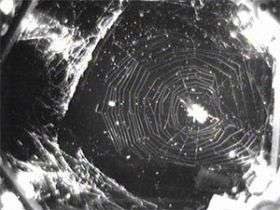Spider Payload on Space Station Becomes a Media Hit, Internet Music Video

(PhysOrg.com) -- A University of Colorado at Boulder payload of web-spinning spiders and wannabe butterflies delivered to the International Space Station by the space shuttle Endeavour Nov. 14 has generated a buzz among scientists, astronauts, the news media and has even spawned an Internet video set to the music of "The Itsy-Bitsy Spider."
The story began Nov. 14 when a payload containing two orb-weaving spiders and six butterfly larvae was launched to the space station by CU-Boulder's BioServe Space Technologies. The project was designed to allow K-12 students to chart the behaviors of the creatures in the near-weightless environment of space and compare them with their earthbound counterparts.
Colorado and Texas students have their own spiders and butterfly larvae in their classrooms and are playing along at home, so to speak, comparing the differences using video and images beamed from the space station back to Earth by NASA.
The story literally "got some legs" following a news item in the Times of London Nov. 16 with a headline reading "NASA Loses Spider on the International Space Station." The report wasn't quite accurate -- the astronauts knew both spiders were in the payload compartment -- but could not see one of them because it was hidden from view.
The spider activity grabbed the attention of the public, appearing in national wire stories, on the MSNBC news Web site and on the Examiner.com Web site headquartered in San Francisco with regional links to dozens of large U.S. cities. The Examiner site posted a video featuring "space" spiders spinning weightless webs as NASA scientists described the behaviors in low gravity and a child's choir sings "The Itsy-Bitsy Spider."
"Don't forget about the butterflies," said Stefanie Countryman, BioServe's payload mission manager. The larvae -- some anchored to the habitat, others free-floating -- should enter the chrysalis, or pupa, stage by Thanksgiving, then emerge as full-fledged butterflies that hopefully will be flapping about in micro-gravity in about 10 days.
For more information on the project go to bioedonline.org/space/index.cfm
Provided by University of Colorado at Boulder





















